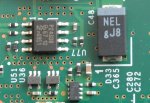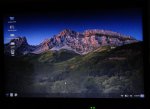Lenovo T400 with locked BIOS
- Vous devez vous identifier ou créer un compte pour écrire des commentaires
Not just password-protected; _locked_.
None of the usual settings can be changed.
HDD in a hard drive caddy in the DVD slot is not recognized.
"Contact your administrator", That's me. Keys available.
DVD drive works OK and the Trisquel_10 Live DVD works;
and a Trisquel_10 flash drive works in a USB port.
Is it locked because somebody entered the wrong password 3 times? Then you have to open the notebook and removing the CMOS battery for 15 minutes. I didnt watched the video but I think it will help if I understand the problem correctly: https://tube.cadence.moe/watch?v=Q9kYRyBOHBs
Nope; unplugged the so-called Backup battery and tried to start the T400 twice;
both times with the requisite 15 minute wait (3/4 hour the 2nd time). Still
getting the "locked" ikon. Getting the palm rest on is a nightmare, and the
drawings are inaccurate: One screw hole is mis-located, and there is no socket
for the Backup battery's plug ... just two pins.
Thanks for the constructive suggestion.
*Edit: Wrong word corrected on point 2, mixed-up things corrected on point 3, something added in point 4*.
Seems to be a difficult problem. I don't know what the solution is, but I'll drop here anything that could help.
1. BIOS enemy: Some BIOS such as the ones from Acer are perversely tricky. They will allow you to set up a password and then never recognize it, preventing you from accessing the BIOS menu ever again. The problem is that they only register the first eight characters from the password, ignore the rest and won't warn you about it. To add insult to injury, they just won't ignore the excess characters. You have to type the first eight characters from the password and then the Enter key to get access again. I hope for your problem to be similar to this, maybe you can find information about it in search engines.
2. BIOS must not lock themselves up: They can't legally require you not to fail at introducing the password, which means that if the BIOS menu becomes unaccessible you can use the warranty to get it replaced. Yes, I know that any T400 is out of warranty by now. But because of causing a replacement under warranty, it is very unlikely for a BIOS to leave you permanently locked out - I have yet to see it. Maybe you just have to wait some hours to try again.
3. BIOS can not lock themselves up: In order to remain locked up, BIOS need to remember their locked-up state. BIOS usually uses static memory such as CMOS memory to store their current state parameters. To get this memory erased, consult the motherboard manual - the usual procedure is to switch a jumper.
4. If all of the above fails, software-rewrite the BIOS. Of course, it would have to be a different BIOS - if just write the same BIOS again, it will continue to behave in the same way. Luckily, for the T400 you can choose from three different BIOS: Lenovo, Coreboot and Libreboot. Study the features to see which one is suitable for you - for instance, Libreboot disallows your computer from running Windows NT anymore. Software-rewriting the BIOS is a tricky procedure with a small but nevertheless definite risk of bricking your BIOS and therefore your whole laptop - be sure to do it with a fully charged battery in order to prevent the procedure to be stopped halfway in case a blackout happens. Most computer BIOS are updateable and therefore they will automaticaly update themselves if at start-up they happen to detect a removable media with an update, be it a CD, a 3.5" floppy disk or whatever. However, in order for this to work, the BIOS still must be working, for it is the BIOS who detects the media and loads the update. If your BIOS blocks you from accessing the menu it might as well refuse to update itself. But even if the BIOS has the self-update disabled, you can rewrite it with the right tool. I used Heimdall.
5. If all of the above fails, hardware-rewrite the BIOS with a different BIOS using an auxiliary computer such a Beaglebone Black or a Raspberry Pi. Hardware-rewriting the BIOS is a tricky procedure with a small but nevertheless definite risk of bricking your BIOS and therefore your whole laptop - be sure to do it with the main computer completely disconnected from electricity (no electrical plug, no battery) and the auxiliary computer either having a fully charged battery or being connected to an UPS, to prevent the procedure to be stopped halfway in case a blackout happens. The procedure requires the main computer to be open and its Flash memory chip connected to the auxiliary computer with a number of wires. Documentation about the procedure can be found at the Librebot website, https://libreboot.org . I did it with a X200, where access to the Flash memory chip is easy (my profile photo shows the X200 with a Libreboot BIOS). For a T400, Leah Rowe of Libreboot said in this very Forum that access is more difficult, kind of requires dismounting the whole laptop.
Hope any of this helps.
Ignacio.Agullo suggested a number of approaches to my T400's password problem, the 5th point of which
brings up the Libreboot/Coreboot solutions, which may come into play after a 6th solution succeeds.
See: https://davidzou.com/articles/bios-password-bypass which describes rather clearly how to reset
the EEPROM, which in my T400 looks like the first attached image. The pinouts & package description
are in the EEPROM's datasheet: https://www.nxp.com/docs/en/data-sheet/PCA24S08.pdf. Access to the
EEPROM is attained by removing the screws shown in the 2nd attached image and then prying off that
back cover, which is easier said than done. The ThinkPad T400 and R400 Hardware Maintenance Manual
by Lenovo is of some help, covering about half the screws that I actually removed.
See: 43y6629_021400130551905.pdf. My next steps involve juggling the exposed guts of the T400 while
watching the display, etc. Wish me luck and steady hands.
OK; once the password gets bypassed, BIOS immediately becomes available. Next step was to disable
the supervisor password. After that I managed to navigate to the Trisquel_10 Live Flash Drive and
install the entire O/S complete with updates. An external keyboard was some help during the task
of hacking the EEPROM. It was of no help for the Trisquel_10 installation, for which I depended
on a USB mouse. Next: get it all back together.



- Vous devez vous identifier ou créer un compte pour écrire des commentaires

